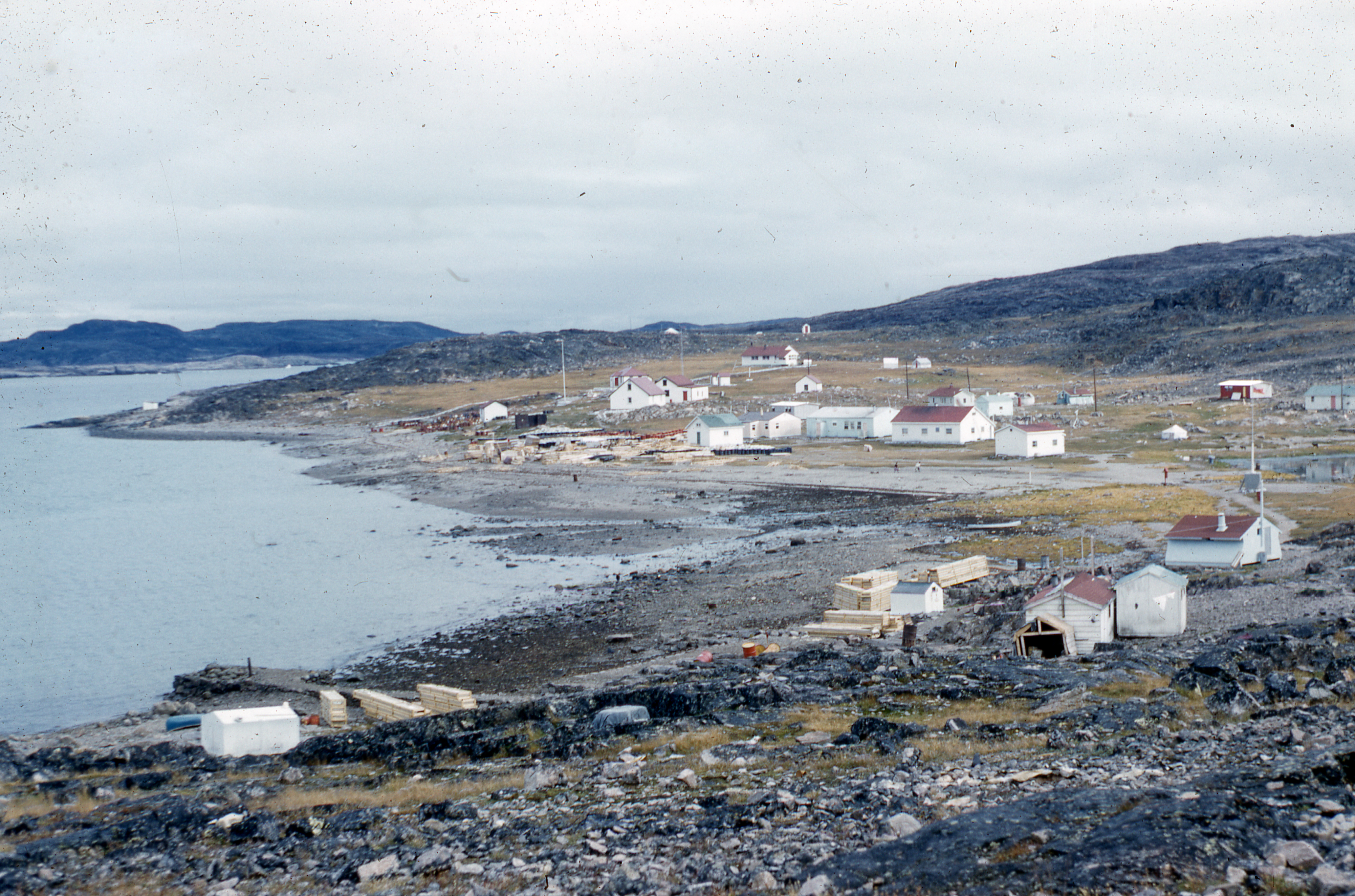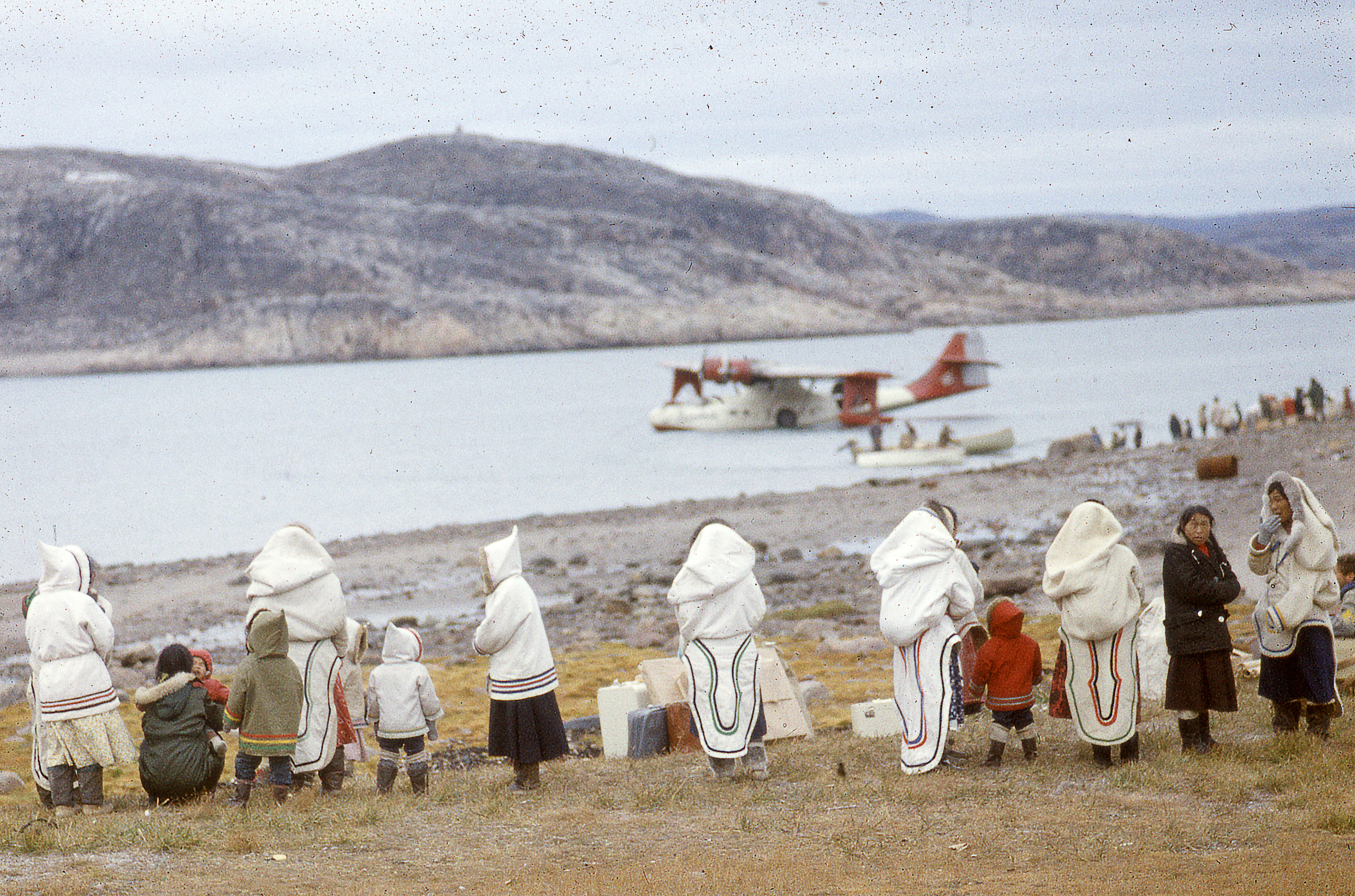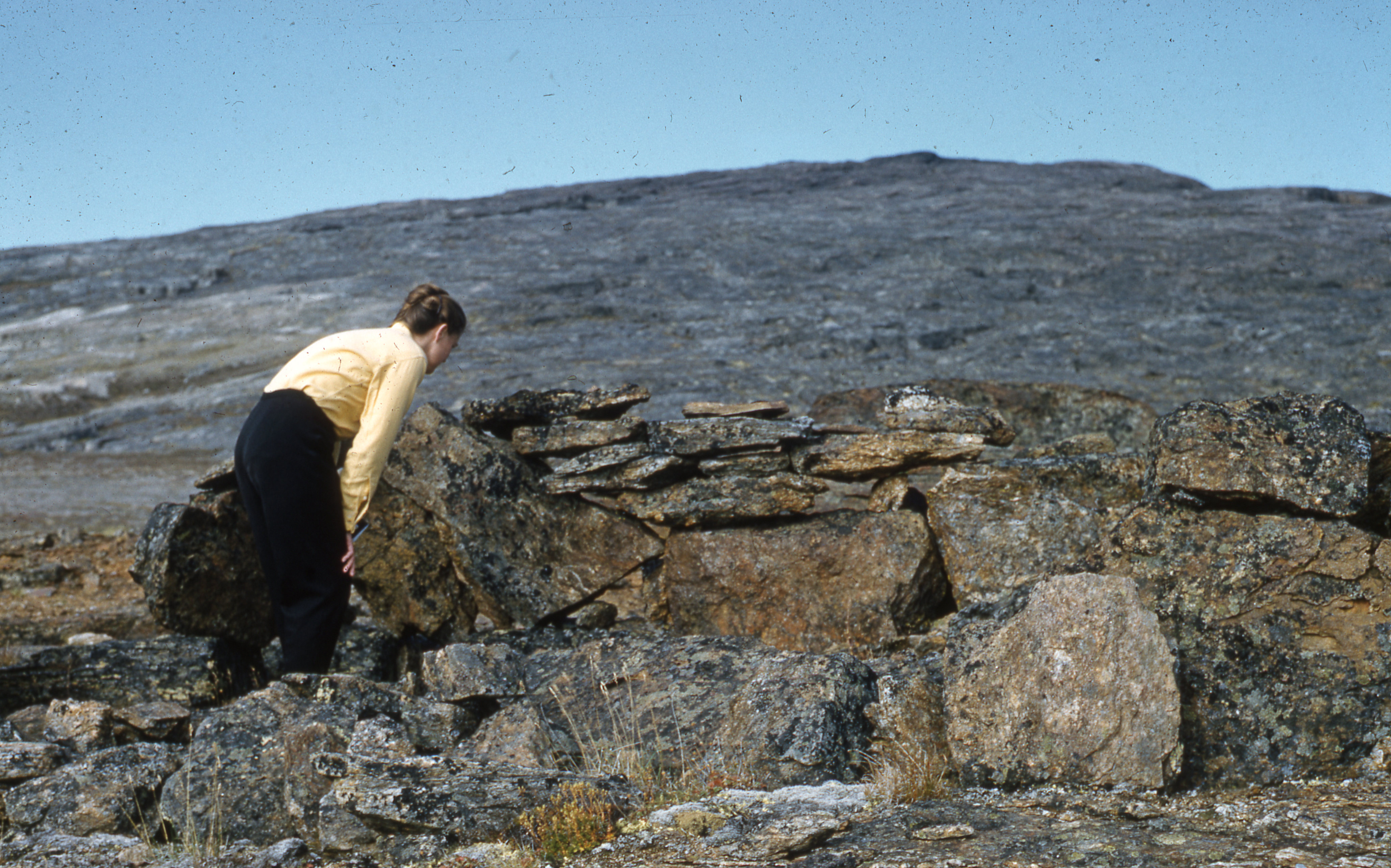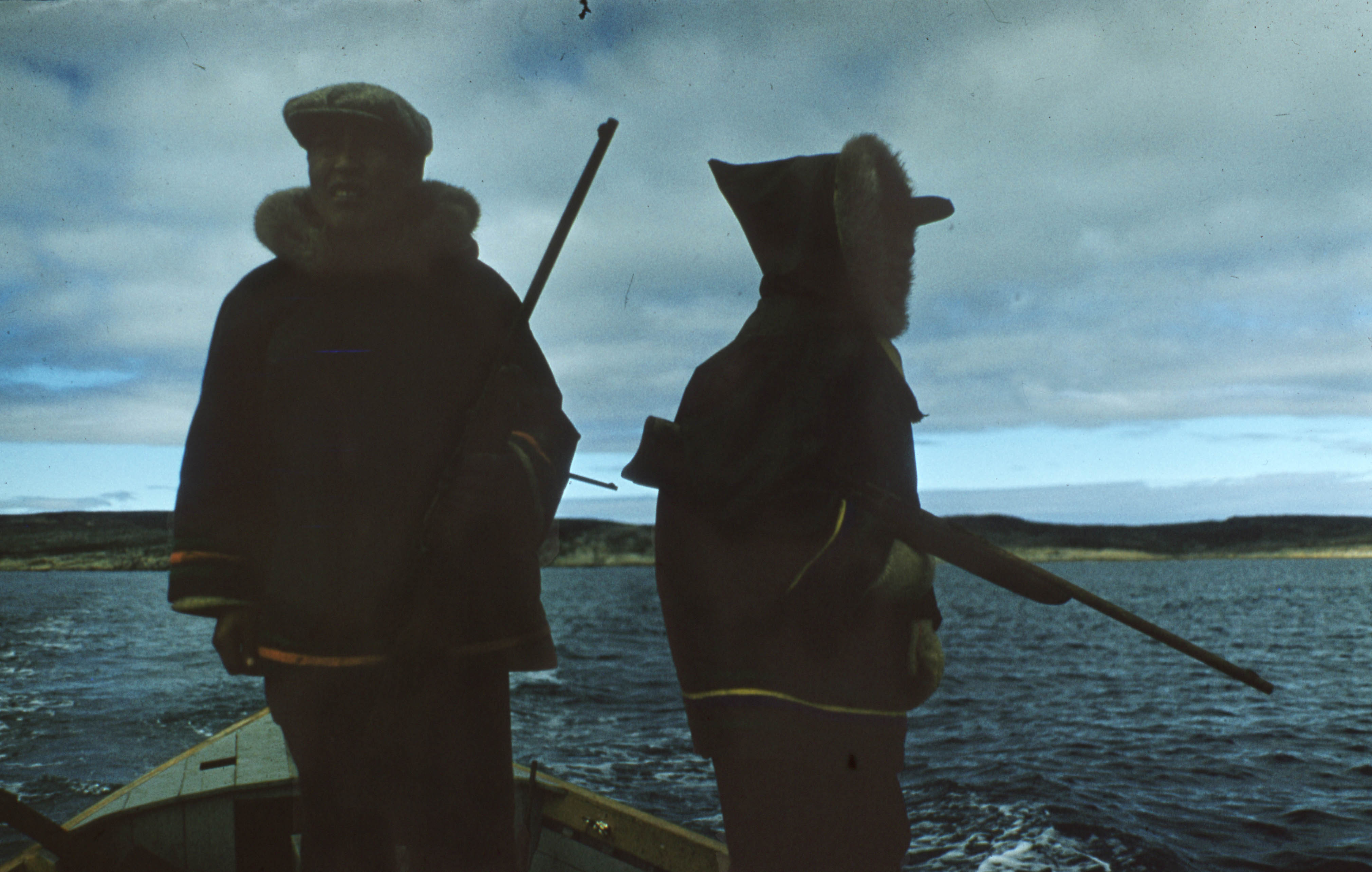Chapter 22 ~ Luxury Camp
Cape Dorset in the West of Baffin Island has an attraction for Northern travelers somewhat as Mecca has for Mohammedans. It is accessible for only six months out of every year if you travel by ship, or by plane, and its very remoteness makes it the more desirable.

In winter, it is best reached by dog sled, when snow and ice give a footing to man and dogs, or by ski-plane during the precious few days when precipitation and landing conditions are favourable. In its brief summer, ships can use its harbour when the waters are ice free, or seaplanes flying at a comparatively low height can go in when there is no danger of their wings becoming iced up in the cold mists which so often shroud the coast.
Our whole venture had been geared to spending as much of the summer as possible in Cape Dorset, but it was not until late August that we were able to reach the isolated settlement of about three hundred Eskimos and a dozen white people.
On August 24, full of nervous excitement, we boarded a cargo-laden Canso seaplane for the flight to Dorset; where the Eskimo language is spoken the most richly, where sculpturing is of the finest green soapstone; where the hunting is most rewarding and where a progressive co-operative had been based on a new Eskimo art form – print making.
Two hours from Frobisher’s airport, we landed on the waters of Cape Dorset harbour. The sun was shining brightly as we taxied over the waves to the mooring place. Peterheads and trap boats bobbed at anchor, canoes lay aslant on the beach and dozens of white tents on shore glistened in a sparkling light.
It seemed as though the whole settlement had turned out to greet the plane and we were ferried ashore in a light aluminum canoe where the first person to shake my hand was an earnest eyed, intense young English missionary.

The Eskimos crowded round in unrestrained curiosity, jostling and smiling eager to remove their mittens to shake welcoming hands. They looked a different race of people from the poorly fed Eskimos we had met so far. Their cheeks were ruddy their faces were tanned and square set, their sturdy limbs filled out their clothing. The women wore spotless white parkas embroidered with brightly coloured threads and they clinked as they walked with rows of old copper coins, jangling at the back of their fishtail parkas. The coins were sewn on to ward off some evil eye if a devil should chance to approach from the rear, and the coins dated to early Queen Victoria’s reign when whalers visited the coast, long before missionaries arrived to route the Eskimo spirits and to tell them of the true devil, Satan.
Rosemary’s friends, Alma and Jim Houston, were waiting to greet us (it was under their aegis we had been able to arrange our stay at Cape Dorset) and they told us our stores had already been delivered by the patrol ship, the C. D. Howe.
We planned to be self-supporting, but immediately on arrival our independence was postponed when we were given an irresistible invitation to join a group of North American journalists at the Arctic’s only Eskimo luxury hunting camp at the island of Tellik. The luxury camp was operated by the recently formed West Baffin Eskimo Co-operative, with a lot of help from the Houstons.
We had met briefly with the journalists in Frobisher a few days previously and they were “doing the Eskimos” with something akin to the speed that North Americans employ when touring the galleries, museums, palaces and capitals of six major European countries in a comprehensive two-week tour.
They were a jovial, mixed bag of men, American and Canadian. Amongst them was a “man from Maclean’s” that veteran of Fleet Street newspapers, MacKenzie Porter, a thoroughbred newshound, born in what he called The Dogpatch of The British Empire – Oswaldtwistle.
For the most part, they were bearded in accepted Arctic fashion and they were dressed like trappers of the wildwoods. They had brought in crates of fresh vegetables, fresh fruit, fresh shell eggs and some old Scotch Whisky, intending neither to contract scurvy nor to lack some solace if they did.
So our first week in West Baffin was spent with excellent company, cost-free at the high-priced summer camp, where Eskimos provided diverting expeditions for sportsmen who found African elephant hunts and Indian tiger shoots were beginning to pall.
The camp was one of the dividends of Art.
The West Baffin Co-operative had discovered Art paid, and under the guidance of Jim Houston, artist and government administrator, the Dorset people had developed an art centre where they made the then fashionable and popular Eskimo prints. The prints were sold Outside and the annual income of about forty thousand dollars was an unaccustomed and fabulous wealth for them.
With some of the net profit, they had set up Tellik luxury camp. The tents were specially made by the womenfolk, and fashioned higher than their own types of tent to accommodate the taller White people. They had furnished them with camp cots, air mattresses, sleeping bags, washstands and bowls and even built two substantial lavatories on the banks of a pretty stream. They would never have made such refinements for themselves. In such a place, tourists could live comfortably in the Arctic, they could hunt seal or walrus, fish for sporting char and hope to bag a polar bear.
Even hot water was provided in enamel jugs and delivered to the tents each morning by an Eskimo boy with discreetly lowered eyes. A bill of fare had been devised to tickle the most jaded palate and for the venturesome gourmet there was moose meat, caribou steak, seal liver and muktuk (muktuk is the delectable pickled skin of a white whale) and for the indefatigable athlete, there was Eskimo dancing.
The campsite was on an old habitation, overlooking a sheltered bay. Its clean white tents were pitched on a broad valley that had been a beach uncounted centuries ago. Rugged granite hills flanked the smooth green turf, and the stream close by drained from a lake a mile up the valley and spilled among the boulders to the tidal shore. Beyond the sound of flowing water was complete quiet and the hills of ancient rock seemed to stretch far away into a distant eternity.
Into this quiet and lovely place, the newsmen erupted on a publicity deal. The Eskimos wanted to attract tourists, and the newsmen had been invited so they could spread information about the camp when they went home. Luckily for us, we arrived at an opportune moment to be added to the guest list, and so we were allotted a two-bed tent with the other journalists.
The co-operative was run by the men of Cape Dorset, but it was Mukituk, a fairly emancipated Eskimo woman, who was the backbone of the camp. Mukituk concocted and cooked the meals. She had a rich streak of independence and had experienced three trial marriages, rejecting each of her suitors in turn. She was the only Eskimo career girl in Cape Dorset.
Alma Houston had taught her cookery, kitchen routine, and how to lay a table, so Mukituk was appointed chef extraordinaire in denim trousers, sealskin boots and an organza apron. She wore her black hair in braids or plaits and could produce a four-course meal after diligent perusal of any one of her three recipe books, all written and indexed in her own clear syllabics.
Her kitchen was well stocked with pots of herbs, an array of new kitchen utensils hung on four inch nails, and it was equipped with a propane gas stove and a refrigerator, obligingly loaned to the co-operative by Mrs. Houston, who cooked for her family on Primus stoves meanwhile.
The meals were served by a remarkably deferential Eskimo youth named Udjualuk, who, according to Jim Houston, was something of a phenomenon. By some strange quirk of character, he did not want to be a hunter like all the other Eskimo men, because he did not like killing animals – an unusual state of mind in a food gathering economy – and Udjualuk was temporarily making a living as a waiter. He also had other talents and played the piano accordion with the verve of a Romanian Gypsy at all the Eskimo dances.
The dining tent had once been a classroom and the home of the Houstons in the days when Alma Houston had taught school, and before the government provided them with a centrally heated, two-story house. It was a large, double walled tent with a board floor, warmed by an oil burning heater and lit by a hurricane lamp hanging from a meat hook on the ridge pole.
The furniture was simple, consisting of two trestle tables and folding camp chairs which were unfamiliar to Eskimos living a semi nomadic existence and whose entire property could be packed on a sled when they went on the trail.
We spent a glorious week at Tellik. Inevitably we went seal hunting with the newsmen, and inevitably, Rosemary and I were committed to the open boat when they went hunting on a rainy day.
We went fishing for char like millionaire sportsmen and savoured our own catch. We tramped over the hills in the wake of pink cartridge cases while the men in the party chased ducks and drakes across the limitless tundra. We listened fascinated while MacKenzie Porter entertained us with his stories of life as a cub reporter in Fleet Street, when he invited the readers to “dare him” to anything they cared to dream of. And we sailed the waters of Tellik in the soft light of the August evenings. Returning home to our tents at the end of a memorable golden Autumn day, a dim figure moved on shore, going from tent to tent, lighting the lamps so the humble canvas dwellings looked like domes of glowing alabaster, warm and welcoming in the cool evening air. The islands around Cape Dorset were the sites of ancient Eskimo camps and the area had probably been continuously inhabited for thousands of years.
One of our excursions from Tellik was to the place of an old settlement, built when the Dorset culture people made houses of stone, roofed with whale bone and skins.
The abandoned houses were on a green turf saddle between two hills on the island of Mallik, and they appeared to have been a village at the edge of a lake. The lake had certainly been the sea shore and now lay a quarter of a mile from, and about forty feet above salt water.
Raised beaches are a feature of Arctic topography and are formed by the gradual uplift of the land since the recession of glaciers which lay ten thousand feet thick in the last great Ice Age. The ice mass depressed the land about eighteen hundred feet in the Hudson Bay area and uplift since deglaciation is probably about nine hundred feet. The land is still rising out of the Eastern Arctic seas at the rate of three feet in a century.
The beaches at Mallik were scattered with a wealth of beautiful rocks, soapstone, steatite; jadeite; rose quartz; serpentine and rough textured metamorphic rock studded with crystals of garnet.
Some of the land was so rich in iron ore deposits that the hillsides were bright orange coloured, like the rusting plate of some scrapyard hulk. A deposit of lapis lazuli, valued by White men, furnished the Eskimo co-operative with another source of wealth, but its exact whereabouts were kept a closely guarded secret, known only to Jim Houston and the Eskimo stone polishers.
The old village remains on Mallik were perhaps two thousand years old. The foundations were rectangular shaped and lay in a carpet of rich green grass. The walls stood some three feet high, standing inside the houses, and all the entrance corridors pointed towards the lake edge, their lintel stones still intact.
In the water lay a profusion of old whalebone, skeletons, walrus skulls and debris. It was a wealth of litter for an archaeologist. As far as was known, no archaeologist had dug on the site, so when the newsmen paddled into the lake they extracted a dozen precious artifacts from their cold mud beds into the fresh light of the Twentieth Century. They found ivory harpoon heads, skin scrapers made of bone, part of a mouth bow drill, burins and a strip of bone about a foot long pierced at regular intervals with neat, round holes – fashioned perhaps, by the bow drill already found. Without waders, I pottered in the shallows where I found a burin and part of a sled runner, but they were of the merest importance when compared with the exquisite treasure one of the men found.
He was a quiet, withdrawn man, but he was so elated by his discovery he was compelled to show it to someone. He came to me when I was apart from the others and said: “If I show you something, will you swear never to tell anyone what it is?”
Such mysterious bait had to be swallowed.
I made my vow, whereupon he produced from his commodious pocket such a rare and lovely work of art that it quite took my breath away. It would have graced the central showcase in Canada’s National Museum if it had fallen into the right hands.
Some time later, Jim Houston said he intended starting a museum in Cape Dorset, and most of us left our puny treasures behind, but the most priceless item, painstakingly fashioned and which could’ve revealed so much of the early Eskimo culture was taken from Cape Dorset when the newsmen boarded their plane and flew South.
The very smell of time and history was in the air of West Baffin Island. Perhaps it was the presence of the old beaches, recognizable as former strands, far beyond the highest spring tide, which gave one an awareness of the earth’s inexorable change.
One morning after the newsmen had left, while Rosemary and I were still camping at Tellik, I rose early and went walking over the mountains as the sun streamed over the hills. I followed a ridge that led east.
The rocks were white and rough like scoured old seabeds, which perhaps they were, forced up by some primeval force. As I reached a darker, higher outcrop overlooking one of the raised beaches, I came upon the foundations of a strange dwelling made from long slabs of stone. It was a man-made shelter and seemed far older than anything we had seen at Mallik.

The slabs were laid end to end and measured fourteen feet by seven or so. It was thickly matted by moss and almost invisible from a short distance, so well was it camouflaged by nature. Close by was a semi-circle of piled stones and as I looked over the end of the ridge, I could see a flat gravel plateau. Directly below me was an upright marker of three different coloured rocks and stretching from it, an old V-shaped line of stones which formed an old fish trap built on the long-dried out watercourse.
Eskimos used to build fish traps across tidal estuaries to catch fish coming in with the tide. They were then trapped behind the low wall of stones when the tide receded and speared in the shallows with three-pronged fish spears which are still used today. I retraced my steps back to Tellik, Rosemary had cooked breakfast, so after a quick meal, girded about with cameras we returned to the small house. Under the thick moss covering the floor, I found fragments of bone, I took a grooved sliver, replaced the moss and left the rest for some archaeologist of the future.
It was our last day in Tellik, so we walked slowly back over the hills. Our path lay through moss, soft as a sheepskin rug and far thicker, the slopes about us a tapestry of yellow, red and brown as Autumn breathed frostily over the tundra.
That afternoon, we waited on the shore for the high tide which would carry our boats back to Cape Dorset, and I was reflecting how life had become geared to the unhurried rhythm of tides when I heard a wild cry of honking geese.
They could be heard long before they came into view and I watched the hills of the northern skyline from where their cries came. They poured over the ridge, two hundred or more migrating snow geese and Canada geese, like a wave undulating across the heavens, changing formation and flowing across the valley of Tellik. They glinted in the sun like a silver chain shaken in the sky. A cloud began to pass its shadow over the land, and I shivered. Our Arctic summer was drawing towards its end.
The tide crept higher up the shore, and soon our loaded flotilla of trap boat, whale boat and two canoes were all afloat and the tents, beds, the kitchen and all its contents had been put aboard, and we set off for Cape Dorset.
The journey became quite protracted as the men sighted and chased a square flipper seal meandering in the channel. He was too wily to be caught and escaped the volleys of shot so we returned to a more sedate course and headed for the settlement.
A flock of eider ducks was swimming ahead in the blue water and before we came within shooting distance, Mukituk the cook, leaped to her feet, pointing and shouting with great excitement. Up came the rifles, rusting and unpolished, shells, whiz-banged and Oshowetuk, standing in the prow bagged three. He lifted them aboard and showed us he had shot each of them clean -through the neck. His family was sure of dinner that night. An hour after leaving Tellik, we reached Cape Dorset, the Eskimos unloaded the boat and helped us to carry our pile of gear to a new camp site.

We were given use of an Eskimo tent because it was much roomier than ours. Within minutes, Oshowetuk and a band of young men had hoisted the canvas over the ridge poles, raised the tent, anchored the guy ropes, battened down the skirt, and opened the low wooden door for us to enter.
We had a new home again.
During a lull while they waited for a washstand to be brought up from one of the boats, I walked over to the Hudson’s Bay Company store to buy cigarettes and handed them over to the Eskimos as I met them coming away from the tent.
When I went inside, I found they had furnished our tent with two cots from the luxury camp, covered them with red blankets and laid our air mattresses on top.
They had even blown up the air mattresses.
That night, Rosemary and I bedded down by candle light, and sitting up in bed, wearing thick flannel pajamas, we broached a bottle of rye whisky and toasted the Eskimos whose kindness made life so worth living, and the bottlers, “The Governor and Company of Adventurers of England Trading into Hudson’s Bay.”

